Universal fighter engineering troops (engineering vehicle lining IMR-2)
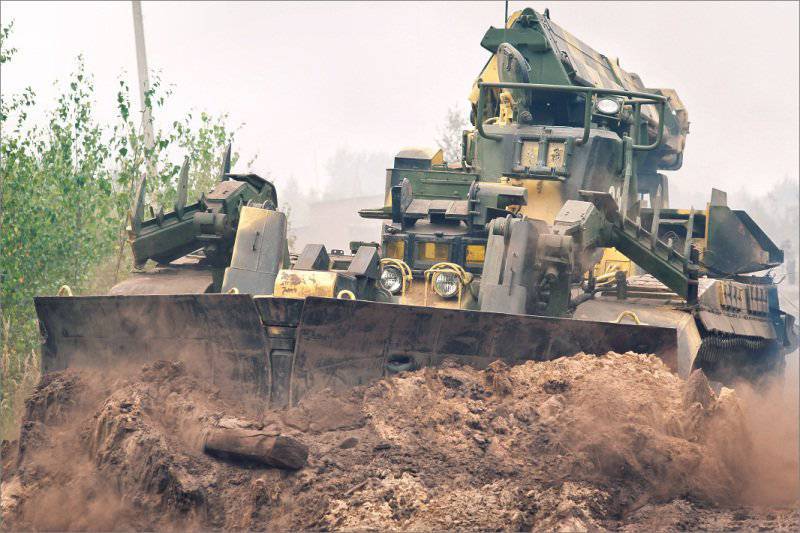
Part one. Little stories
It so happened that the history of engineering technology, in contrast to the history aviation, tanks and even fortifications, always pay very little attention. It all comes down to the technical specifications and year of manufacture. It is understandable - information on the history (EXACTLY HISTORY!) Of engineering equipment is very insignificant. In this article, the author tried, as far as possible, to reveal some points in the history of the development of the IMR-2 barrage engineering machine. This issue still remains relevant, especially on the next anniversary of the Chernobyl accident, where the IDPs have demonstrated all their capabilities.
During the conduct of hostilities, there is a need to ensure the movement of troops along the tracks (military roads) or their equipment and support. 1933 introduces the concept columned way - selected on the ground direction outside the roads, prepared for short-term movement of troops. The main work on preparing the column path was: marking the route, reducing the angles of descent and ascent, strengthening the marshy areas with wooden shields, clearing the path from debris, snow, mines, etc. New machines developed on the basis of the CTZ tractor are put into service: a busbar cutting machine, a tractor shovel, mechanized rollers, a snowplow. At the end of 1930's Bulldozers, trenchers and the like are entering the troops. After the war in 1950-60-s. more advanced machines BAT, BAT-M, more advanced attachments were developed. But the greatest development of the machine for the preparation and maintenance of column paths, ensuring the rapid movement of troops, clearing debris, including in urban buildings, received during the appearance of nuclear missile weapons (second half of 1960's). The increase in the volume of tasks, changes in their content, terms and conditions of implementation led to the creation of an engineering machine for the overlapping of the WRI.
Engineering obstacle machines belong to the group of machines intended for making passes, clearing debris and destruction in the engineering support of military operations of troops, including in radioactively contaminated areas. To perform these tasks, the machines are equipped with dozer, crane and additional (bucket, scraper, drill) equipment.
The bulldozer equipment in such cars is universal. It can be installed in one of three positions:
- dvuhotvalnoe, which is the main and is intended for the device passes in the rubble and destruction, laying of column paths, removing the top radioactively contaminated soil layer;
- bulldozer, which is used when setting up congresses, backfilling dredging, moving soil and self-digging;
- grader, used in the device of column paths on slopes and other types of work that require moving the ground (snow) in one direction.
The boom equipment in most cases is equipped with a gripper-manipulator, which allows you to perform a large complex of works on arranging aisles in the forest and stone rubble.
As additional equipment, a mine clearance installation and an anti-mine trawl can be installed on the machine.
This group of vehicles also includes sapper tanks and some engineering vehicles that can be used for engineering work under the fire influence of the enemy and in conditions of mass destruction (American engineer tank M728, German Pionierpanzer-1, etc.).
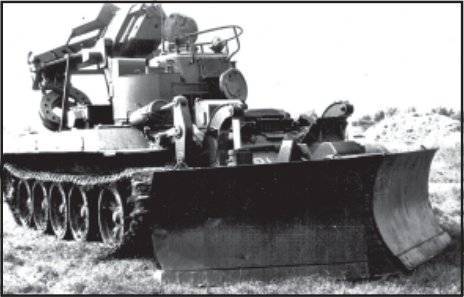
WRI first
The first Soviet WRI was developed in Omsk based on the T-55 tank. It was put into service in 1969. The main equipment of the machine included a universal bulldozer and crane equipment with a gripper. It should be noted that a machine of this class appeared in the West (in the USA) four years earlier: in the 1965, the M728 “engineer (sapper) tank” entered service. The American was superior to the Soviet machine in terms of the lifting capacity of crane equipment (8 t against 2 t for WRI), but the Soviet machine was lighter, more maneuverable and more versatile due to the gripper.
With the adoption of a new generation of tanks (T-64, T-72, T-80) and changes in the organizational structure of the tank and motorized rifle divisions (the program "Division - 86"), it became necessary to create a new lashing machine on a more modern base. This machine was the IMR-2, made on the basis of the T-72A tank.
Robots on the IMR-2 began in 1975. The machine (general idea and design) was developed in Omsk under the leadership of A. Morov, and the working equipment and the development of design, design and technological documentation in the Chelyabinsk SKB-200 and Novokramatorsky Mashinostroitelny Zavod (chassis refinement, hydraulics, lead developer of experimental machines).
The main working equipment - a telescopic boom and dozer blade - was worked out on the previous machine, and their modernization and adaptation to the IMR-2 did not cause difficulties. New equipment on the machine became mine trawl and installation of mine clearance. We will dwell on them in more detail.
The new equipment was developed by a special design bureau of the Chelyabinsk Tractor Plant - SKB 200, under the leadership of V. A. Samsonov in cooperation with the Novokramatorsk Machine Building Plant. B. Shamanov and V. Samsonov were engaged in launching (PU) demining, and V. Gorbunov was engaged in the mine trawl. The works were carried out under the general supervision of V. Mikhaylov, Head of the Advanced Development Bureau.
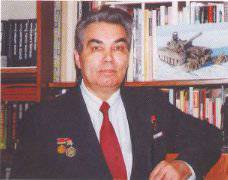
Designer SKB-200 V. Mikhailov
If everything was more acceptable with the mine sweep, then the location of the launcher on the WRI housing, the proposal by Samsonov, did not suit the main developer of the machine. Four cartridges with demining charges (with a total weight of 1200 kg) were located at the stern of the machine and were tightly bolted to the body. At the same time, they hung over the transmission hatches, which had to be opened with daily maintenance. In addition, although the cartridges with charges were shifted as far back as possible, it was difficult to turn the boom of the MRI manipulator from the traveling position forward. Even in the raised position, the arm of the manipulator hit the top of the cassettes. All this did not suit the head developer, and he raised the question of excluding PU from the WRI. But the military insisted. The head of the Advanced Development Bureau V. Mikhailov proposed to make the PU mine clearance trailer, since several years ago such an option was already developed on the wheelbase of the KB-200. It was much easier and cheaper. But the task was approved from above, and it had to be carried out.
(Approximately in 10 years, a similar demining installation MICLIC appeared in the USA. The charge was a chain of 140 explosive blocks СХNUMX strung on a cable. Feed to a minefield using a powder rocket. A charge was placed and transported in a uniaxial trailer container.)
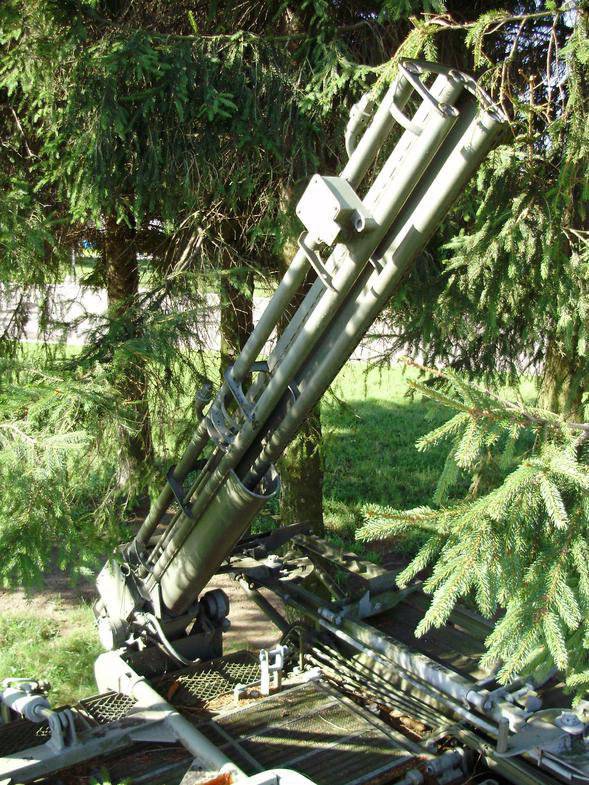
PU guide installed in the stern
The following sentence by V. Mikhailov was as follows: install the cassettes on the frame, and move the frame as far back as possible so that the cassettes do not interfere with the boom of the manipulator. Hanging from the stern of the frame reinforced struts. Offer accepted. In addition, it was proposed to make wood cassettes of charges and discharged after ejecting charge demining, which reduced the weight of the machine by 600 kg (there was an advantage in 2 t for WRI, therefore they were looking for any ways to reduce the weight of the machine).
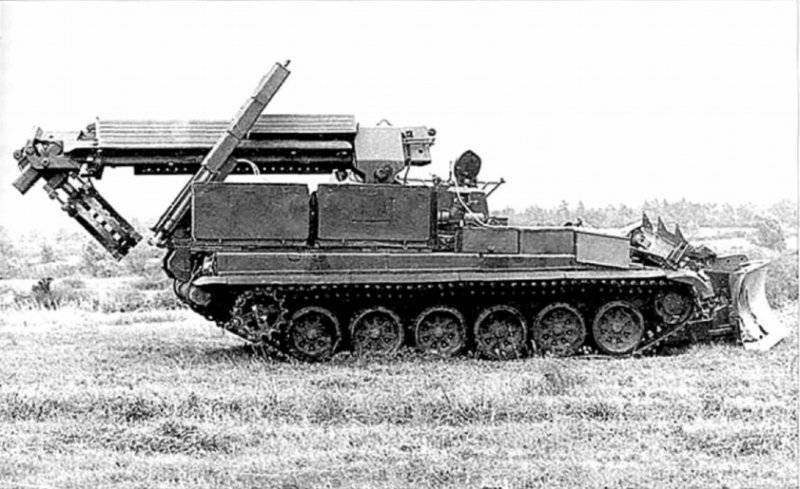
IMR-2. Clearly visible PU charge clearance at the stern of the hull and large boxes for clearance charges
Wooden cassettes not only reduced the weight, but also did not collapse from being dropped from the machine (the metal was often deformed). Also, the presence of wooden cartridges with demining charges made it possible to simply change them instead of reloading (as previously envisaged) into metal cassettes. Resetting the cassettes also met the requirements of the head developer, as the boom conditions improved. To reset the charge clearance cartridges, an original method was invented. The cassettes were placed on frames that moved on special semi-blocks from side to side to access the transmission hatches. To reset, they decided to use the tension force of the brake cable, which held a clearance charge in flight. The rope was attached to the semi-blocks under the cassettes. When the rope was pulled, the semi-blocks were turned, uncoupling the cassettes and resetting them.
There were some minor problems with the installation of the mine trawl. Its developers did not suit small amounts of space between the bulldozer raised to the marching position and the machine body. It was literally a slot for a knife trawl, which, in the stowed position, also had to lie on top of the nose of the WRI. Initially, there was a proposal to abandon the knife-trawling trawl, and its knives should be positioned across the entire width of the bulldozer WRI (as was done on the American trawl Т5Е3) and make them removable. At the same time, a minesweeper with a passage width of about 4m could have turned out. But the officers of the Scientific and Technical Committee of the Engineering Troops did not even want to listen (again, ten years later, this idea was embodied in the American COV pillage machine, in Russia at present they have returned to this idea in the engineering car - RF Patent No. 2202095). After a long search for a solution, they came to the conclusion - to take the old knife sections from the KMT-4М trawl, since they were smaller in size than the new sections of KMT-6. Lifting the trawl to the stowed position was carried out by hydraulic cylinders. For trawling mines with a pin fuse (type TMK-2), the knife sections were equipped with two horizontal spring-loaded rods.
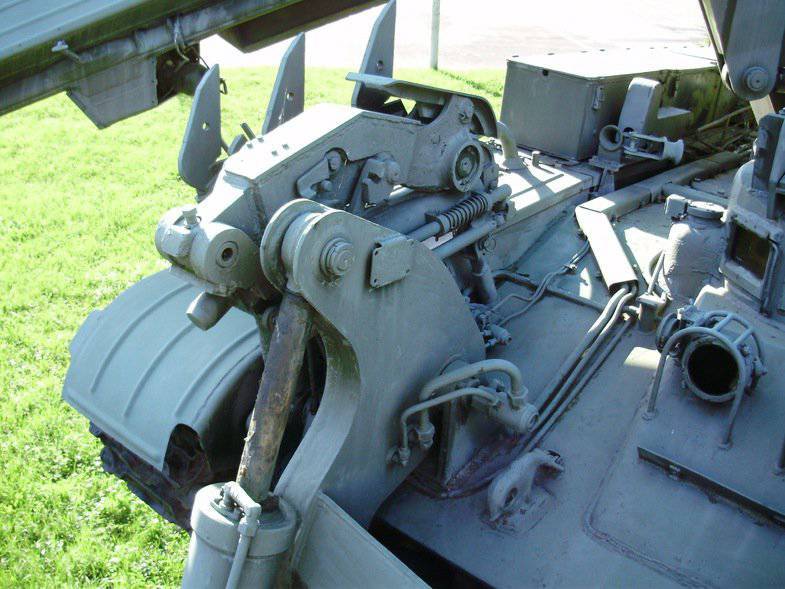
Mine trawl KMT-4 in the stowed position
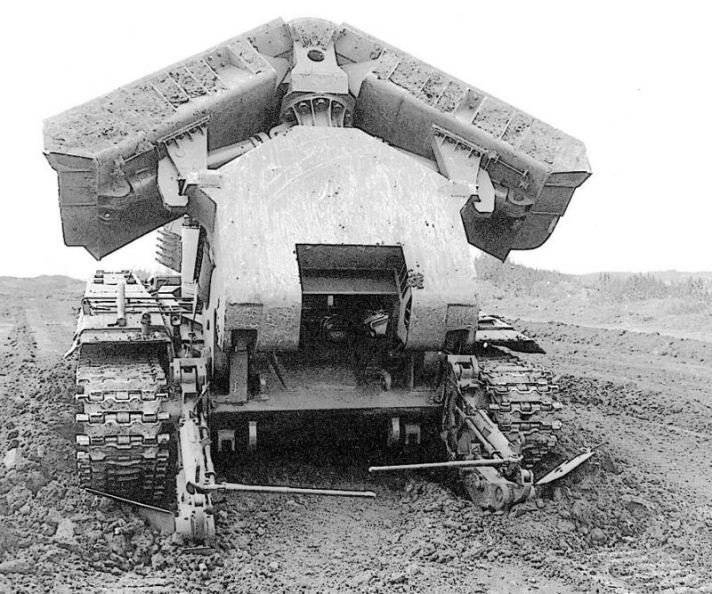
Trawl KMT-4 in working position. Metal rods are clearly visible, horizontally disposed and designed for trawling anti-bottom mines with a pin fuse
Gradually, all issues were resolved and the developers began to manufacture prototypes of WRI. To install the mine trawl and PU demining, a locksmith, a welder and a designer left Chelyabinsk for Kramatorsk on a lamination machine. Later, the head of the military acceptance of the Colonel N. Omelyanenko and the designer V. Mikhailov went there for acceptance of the MRI.
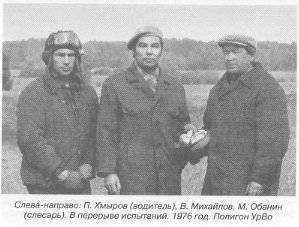
And in April 1977, the WRI prototypes were sent to factory (preliminary) tests at Tyumen, at Andreevskoe Lake. V. Mikhailov wrote that he had bad memories from the tests: the officers who led the tests of the launcher and the trawl made many deviations from the test program, the operating instructions and safety instructions were often violated. Also, after the launch of the demining charge, it was necessary to measure its deviations: plus or minus 10% in range and 5% to the side. All this had to be measured at a side wind speed of no more than 5 m / s. But this was neglected. So, after the next launch (lateral wind speed reached 8 m / s), the charge went at an angle 450 from the launch direction. The angle recorded, and the wind speed is not. Comforted V. Mikhailov while this only the fact that when jerking the brake cable, even at an angle of 450, the empty charge cassettes were thrown from the board to the ground.
At the next launch, another emergency occurred: the force of the flame from a jet engine of a demining charge was blown by the wind into the gaps above the transmission of the car, and fire detectors were triggered. The space in the car filled with inert gas. The operator and mechvod (young soldiers) were terribly frightened. When leaving the car, the mech-driver hit its head against the hatch and received a light contusion (a headset was put on). After that, it was recorded in the instruction manual that the charge starts to be made only with the transmission compartment louvres closed.
After testing, PU began to test the mine trawl. Since there was still snow, the trawling of inert mines was carried out by a winter trawling device (ACE): special gratings of plates were put on the trawl knives of the trawl. Of the 180 mines installed in the snow, only two were missed, i.e. trawling quality was 99%. The quality of trawling mines installed in the ground was 100%. In general, tests of PU demining and trawling were successful.
The same tests showed that the 150 kg of weight can be saved on the machine - this is the protection of the detonation transfer device (DFC). The shelling of the demining charge and the small fire unit DFC showed that they do not explode. Therefore, the position of the DAD was slightly changed (it was put in charge with the cassette) and another test was performed in January of the 1978 year. They passed near Kharkov in the presence of Colonel Alekseenko, the chief of the engineering troops of the 6 Army. In honor of Alekseenko, the clearance charge was fired (800 kg) and then it was blown up. The tests were successful.
The next were state tests, which took place in the summer near Kiev. They ended successfully, although they were darkened by tragedy - SKB-200 designer V. Gorbunov received serious injuries. The cause of the tragedy is trivial - a violation of safety. At one of the launches, the guide with the charge did not rise to the desired angle (on 100 instead of 600). Something happened to the mains. According to the instructions it was necessary to turn off the electrical equipment of the machine. This is not done. The work manager called the designers from Kramatorsk (the lead developer), they punished the electrician to see what happened. Immediately approached V. Gorbunov. Instead of driving away the electrician and performing all the operations according to the instructions, he became behind the PU. The electrician at that time closed the starting circuit of the jet engine (which, again, contrary to the instructions, was on the rail). Force flame struck the electrician in the shoulder, and Gorbunova straight in the face. V. Gorbunov was treated for a long time, but until the end he was unable to restore his sight and hearing.
After all the tests, mass production documentation was prepared and protected. In 1980, the Central Committee of the CPSU and the USSR Council of Ministers dated 28.04.80 No. 348-102 and the order of the Minister of Defense against 03.06.80 No. 0089 engineering obstacle was adopted by the Soviet Army under the designation "IMR-2".
In May, 1981 was a group of creators of IMR-2 from Kramatorsk and Chelyabinsk awarded orders and medals. So, V. Gorbunov, who was injured on probation, was awarded the medal "For Valiant Labor".
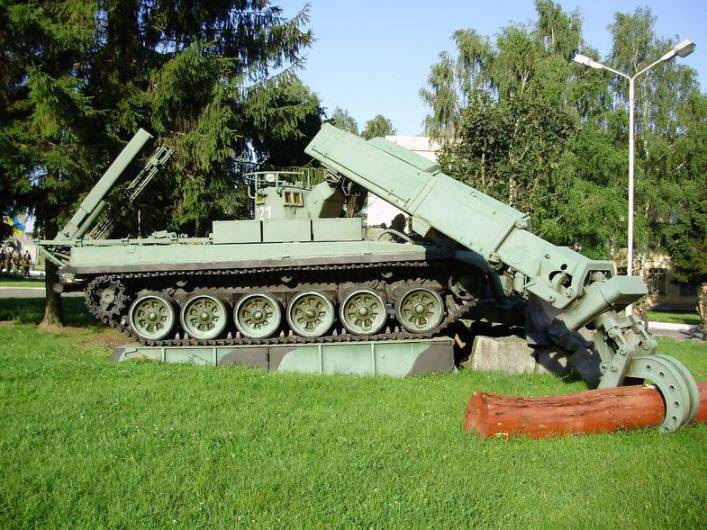
IMR-2 (Novograd-Volynsky)
At first, IMR-2 was supposed to be produced in Omsk at the local transport engineering plant, but from 1976 it was reoriented to the production of T-80 tanks. Therefore, the decision of the Central Committee of the CPSU and the Council of Ministers of the USSR from 27 July 1977, this responsibility was assigned to Uralvagonzavod (Nizhny Tagil), where it was planned to build a special building. But its construction was delayed, and the first 10 chassis IMR-2 collected in tank shops. Only in 1985 the mass production of the IMR-2 chassis began, which were then completed at the Novokramatorsk Mechanical Plant.
IMR-2 is designed for the equipment of aisles, clearing debris and destruction during engineering provided combat operations of troops, including in the radioactively contaminated area. In addition, it can be used for towing damaged equipment from the paths of movement of troops, for carrying out rescue operations in areas of mass destruction, and the like.
The first WRI-2 began to enter the army at the beginning of 1986. Lt. Col. Evgeny Starostin, who in 1985-1991, remembers. served in the 306 separate engineering battalion of the 24 MD battalion (Yavorov, Ukraine) as a platoon commander and later a company:
- In February-March 1986, we received a new technique. These were the engineering machines lining the IMR-2. The retooling was carried out in accordance with the directive of the General Staff on the reorganization of the Armed Forces, and more specifically in the framework of the “Division-86” program. At this time, there is a new offensive doctrine, change the staff of the units, all get a new technique that could provide offensive actions, in this case, our mechanized division. In engineering subsections, such a machine was IMR-2. When we received new cars, there were certain difficulties. First, tankers drove them off the railway platforms, because the mechanics for the IMR-2 were trained in the Baltic States, and at the time of receiving the new equipment in the division they simply did not exist. Tankers generally helped a lot. But basically I had to do everything myself: read the technical “Manuals”, press the buttons myself, put pressure on the levers. I studied in older tanks, and the T-72 tank as the base of the car was new to me. Overall, IMR-2 was similar to the previous IMR, but the internal equipment was smaller in size. A novelty was the appearance of the knife trawl and the installation of mine clearance. Regarding control, it was simpler and easier in the WRI-2, unlike the WRI, due to the fact that it was a hydraulic transmission, not a mechanical one. A novelty was also the PAZ system. What is its essence? When the GO-27 radiation and chemical reconnaissance device detects a threat, the system stops, shuts down the engine, closes all blinds and seals the car, turns off the power supply, only the radio and emergency lights are working. In 4,5 seconds Includes filtering unit. Further (approximately seconds through 15-20) it is already possible to start the engine. When I first tried the PAZ on myself, I was in shock - the engine stalled, the car stopped, everything knocks, closes, the lights go out. Feeling like a kilka in a jar. It's funny now, but then ...
Very successful was the working body - the manipulator - and the peculiarity of working with it. She was light and very versatile. So, my old soldiers could manage to close the open box from matches by means of a manipulator.
As for the most basic machine - the T-72 tank, I would say that the machine is protected, comfortable, reliable, easy to operate.
It should be recalled that to the main equipment (bulldozer, crane, anti-mine trawl) added installation of mine clearance, which is located in the rear of the machine and includes the right and left guides with demining charges. Its presence was determined by the fact that IMR-2 will make passes in the minefields and mine-explosive obstacles of the enemy to ensure the advancement of troops.
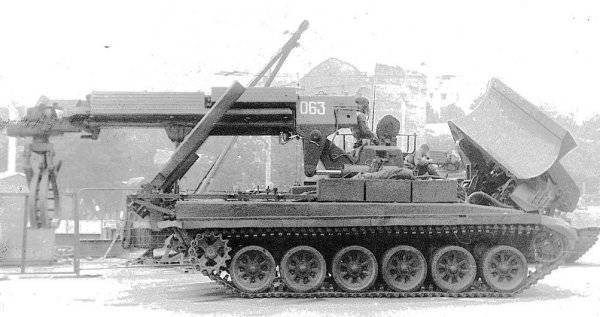
IMR-2. Bulldozer oval and boom with a gripping manipulator in the stowed position, and PU demining charge raised to the combat position
Yevgeny Starostin:
- Regarding the installation of the mine clearance UR-83. It is not known why she was on this machine at all. There were a lot of problems with her. Suffice it to say that the charges to the installation were located in wooden boxes on both sides of the car. And this is 1380 kg of explosives. And this is a car that must operate in the first echelon, along with tanks. An RPG grenade hit, whether there was a queue of bullets - and the machine didn’t seem to exist (the launch charge distance is only 500 m). Preparations for the launch of demining charges were done manually by the crew leaving the car! And this during the battle ... Another problem was the launch of the charges, which were located near the engine compartment. And if the driver forgot to close the blinds of the quick branch, then the demining charge starter motors could disable the engine and cause a fire in the car. During the liquidation of the accident at the Chernobyl station, it was generally useless, only delivered a lot of problems to the special people (the installation is something secret).
Description of the design and basic tactical and technical characteristics
Structurally, IMR-2 consists of a base machine and work equipment.
— Basic machine (product 637) is an armored tracked vehicle, made on the basis of components and assemblies of the T-72A tank, and is designed for mounting various equipment on it. To do this, some changes were made to the body of the “637 product”: the bottom was rebuilt, the substructure of the sheet was redesigned, the observation devices were replaced with sight glasses, the fastening elements of the working equipment were welded to the nose, etc. The machine body is divided into two sections: control and transmission. Department of management is located in the bow (place mechvod) and the middle parts of the body (operator). The transmission compartment occupies the back of the case, it contains the engine of the machine, located transversely and offset to the left side.
For driving at a given course in conditions of limited visibility and lack of reference points, the base machine has a hygro-semi-compass. Mechanical observation devices include day and night observation devices, which ensure driving and operation of the IMR-2 at any time of the day. Also, the machine is equipped with a system of protection against weapons of mass destruction, smoke suppression system and fire equipment. For defense, the machine is armed with a 7,62-mm machine gun, which is mounted above the operator's tower.
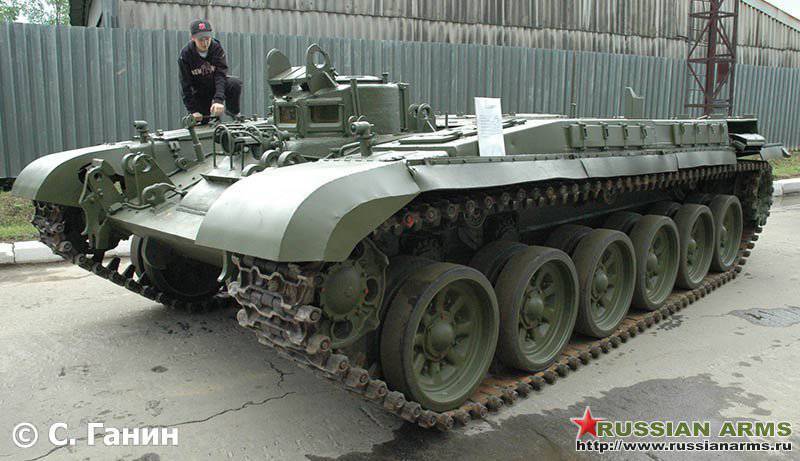
Basic chassis IMR-2
— Machine operation equipment consists of a universal bulldozer, telescopic boom with a grip, track mine sweep, installation of mine clearance.
Universal bulldozer designed for the development and movement of soil, clearing snow and bushes, felling trees, stumping stumps, making walkways in forest obstructions and destruction.
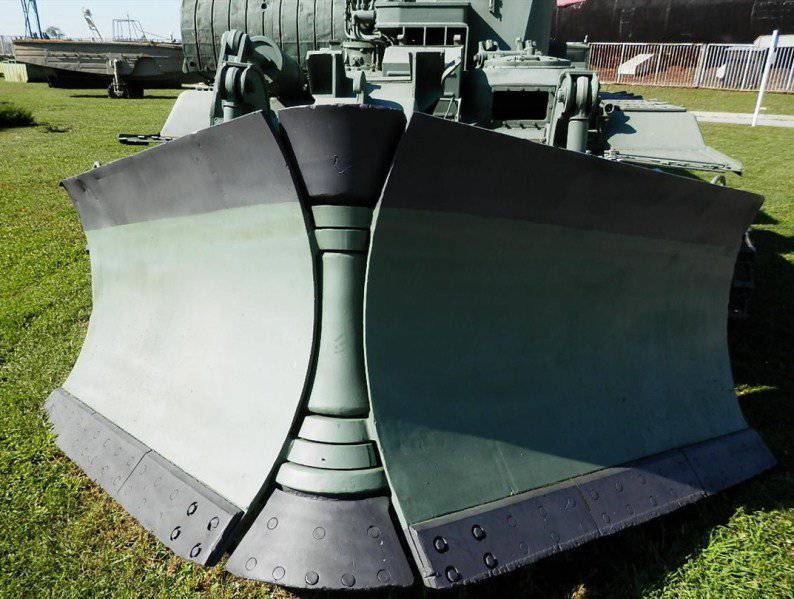
Universal bulldozer IMR. Front view
It consists of a frame, lifting, lowering and skewing mechanisms, a small central blade and two lateral moving wings. The center blade is a welded structure that attaches to the frame and can be rotated right and left on the 100. The wings of the blade (right and left) are similar in design, their front sheets have a curved surface. Knives are bolted to the bottom of the frontal sheet. Due to the mobility of the lateral wings, the bulldozer can occupy one of three positions: dozer, two-tail (path-laying) and grader. The universal dozer is controlled by a driver without getting out of the car.
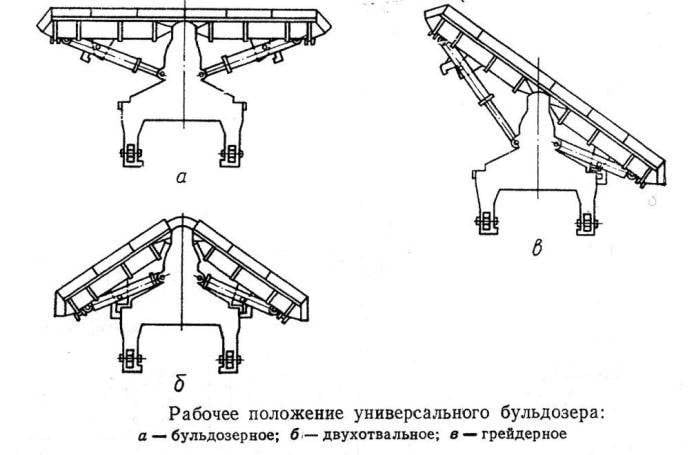
The main working body - telescopic boom - pivotally attached to the bracket of the tower, located on the turntable. The arrow has an original manipulator that copies the actions of the human hand and has six independent positions. The boom and the manipulator are controlled by the machine operator from the tower's console using an electro-hydraulic system. In the course of work, the following operations can be performed: boom rotation, boom raising and lowering, boom pulling in and out, gripping raising and lowering, gripping rotation, opening and closing of the gripper. The design of boom equipment allows you to combine individual operations, but no more than two. For example, turning the boom and opening (closing) the grip, etc.
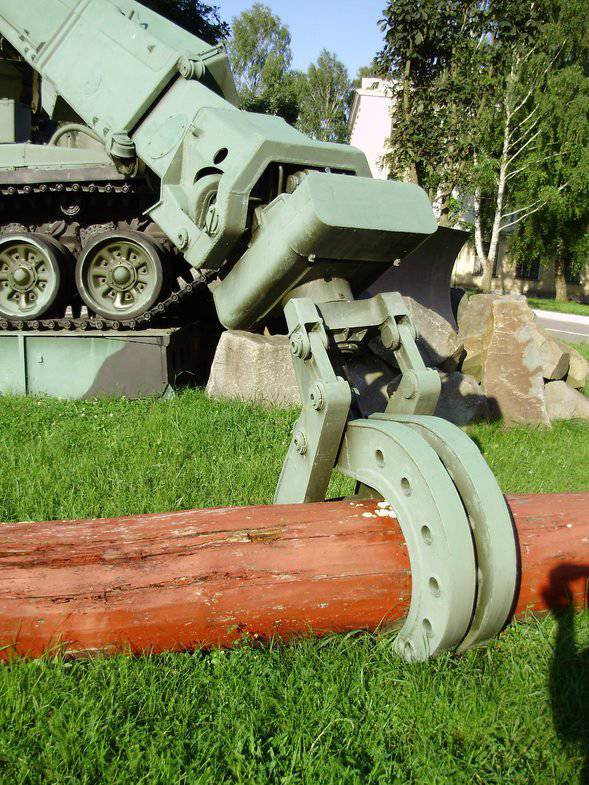
Gripping arm in working position
KMT-4 track mine trawl It is an integral part of the IMR-2 and is intended for the machine to overcome independently the anti-tank minefields from all types of equipment, including protivnischevyh with pin fuse. The trawl consists of three main parts: the right and left knife sections (of a similar construction) and the translation mechanism. The knife section consists of a working body (three cutting knives, a box-shaped blade, a folding wing), a balancer, a balancing device, a pin device for trawling anti-bottom mines, a replicating ski relief and a trawling winter device. In the working position, the trawl knives are buried in the ground. If a mine is caught in their way, it is knocked out of the ground with knives, falls into the dump and is taken aside for the tracks of the tank.
Installation of mine clearance (SD) is an additional equipment to the mine trawl and is designed to make passes in the minefields and mine-blast obstacles of the enemy in order to ensure the advancement of troops. It is located at the rear of the machine body and consists of two (right and left) guides for launching demining charges. A jet engine is placed on the guide, which, when launched, pulls a charge of clearance after itself and sends it to the minefield. The demining charges themselves are in wooden cassettes (two per board) at the rear of the hull on fences. Preparation of charges for launch is made by the crew manually with his exit from the car.
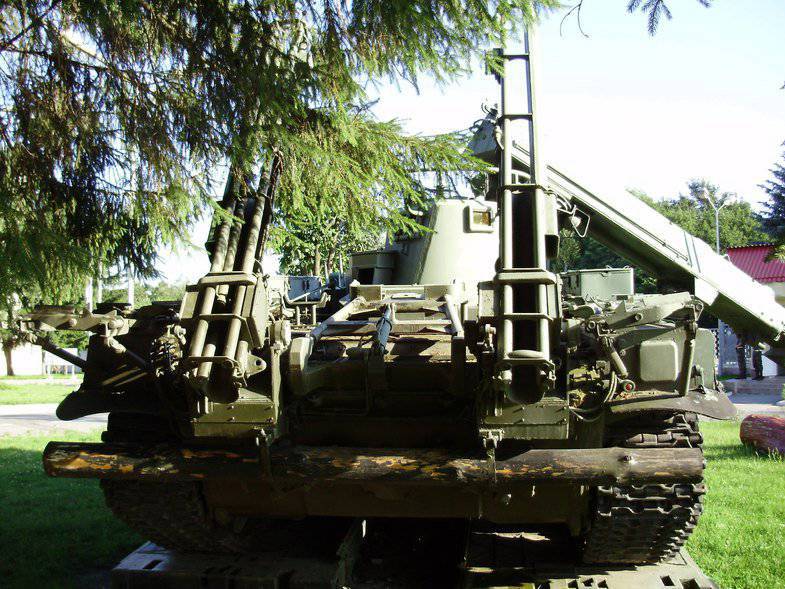
View of PU demining rear
Main TTX machines
Base vehicle: T-72А tank tracked base (637 product).
Mass with removable elements (KMT, UR knife trawl), t: 45,7.
Crew, person: 2.
Performance:
- in the preparation of column tracks on middle terrain - 6-10 km / h;
- when equipping the passages in the forest debris - m / h 340-450;
- at the equipment of passes in stone blockages - 300-350 m / year;
- when developing the soil with bulldozer equipment (falling asleep of ditches, funnels, etc.) - 230-300 м3 / year.
Overcoming obstacles, hail:
- maximum angle of elevation - 30;
- The maximum angle of heel - 25.
Dozer blade width, m:
- in the two-tail position - 3,56;
- in bulldozer position - 4,15;
- in the position of the grader - 3,4.
Boom lifting capacity, t: 2.
Speed, km / h:
- on the highway - 50;
- on dirt roads - 35-45.
Launcher:
- number of guides, units: 2.
- max. angle of elevation of guides, degrees: 60.
- range of demining charge, m: 250 — 500.
Power reserve, km: 500.
Perform basic engineering tasks
Passages in the forest rubble They are made by pushing the bulk of the dam down with the bulldozer blade, as well as pulling and cleaning the boom with the manipulator of individual trees that impede the work of the bulldozer (usually protruding above the level of the blade or creating a threat of damage to the elements and components of the machine). In this case, the blade of the bulldozer is set to the two-tail position, and the boom with the manipulator turns around and is set to be gripped in front of the blade.
Stone arches depending on their height and length, they are made either by clearing to a solid base with a height of dam up to 50 cm, or, at a higher height, by a device to travel on top, for which entry and exit from the dam is arranged. With a high dam height, its crest collapses with the aid of a manipulator, large debris is removed to the side or stacked in a ramp.
In the rubble in the settlements WRI makes the aisles as well as in the stone walls. But at the same time on the sides of the blockage it is necessary to bring down the dangerous elements of the buildings (walls), pillars, masts, etc.
Congresses to the crossings IMR-2 arranges by cutting off coastal steepness (cliff) or cutting off slope. When cutting off a slope, the driveway is arranged in the form of a half-groove - half-spit by successive cutting of the slope. The blade is placed in the grader position, and the trimming itself is performed by the blade wing turned forward.
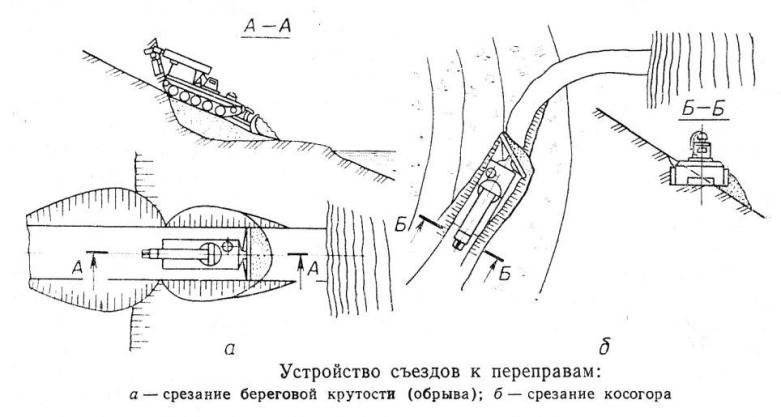
The machine produces rolls of individual trees with a diameter of 20-40 cm by cutting them with a blade to the root. Trees with a diameter of more than 40 cm fall with a manipulator with simultaneous or preliminary pruning of the root system. Rooting up stumps with a diameter of up to 40 cm is done by cropping the root system by deepening the blade on 15-20 cm for 2 m before the stump.
Digging pit the machine produces a blade installed in the dozer position, with sequential reciprocating motion. The earth from the pit periodically moves to the parapets.
On radioactive and chemically contaminated terrain, WRI performs all kinds of the above work, but with a complete sealing of the machine.
To be continued ...
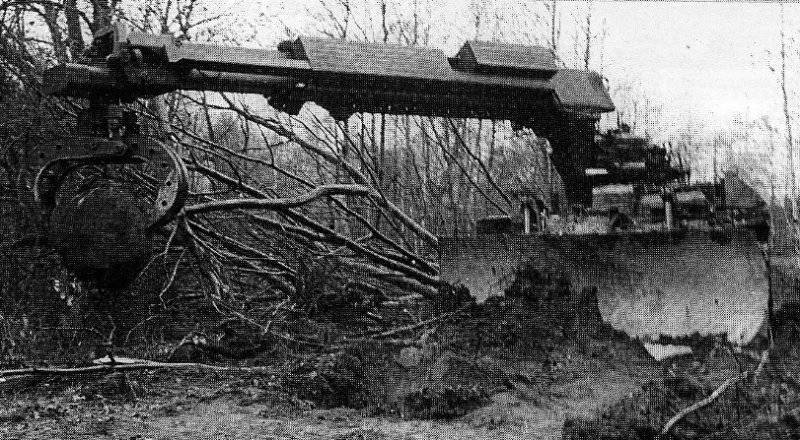

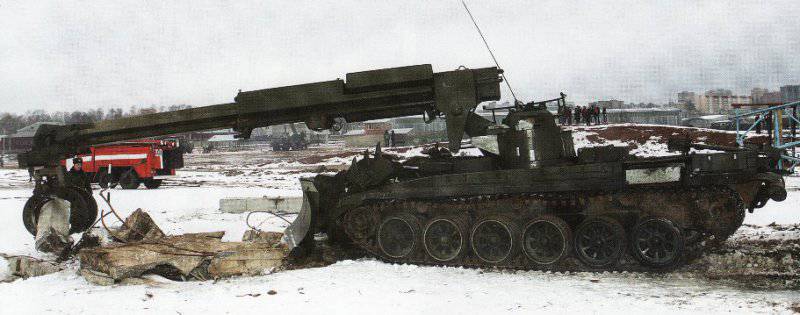
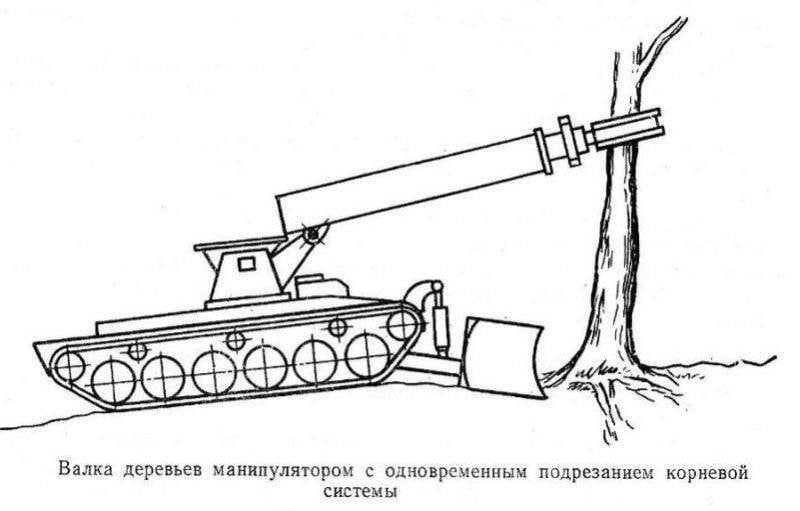
Information